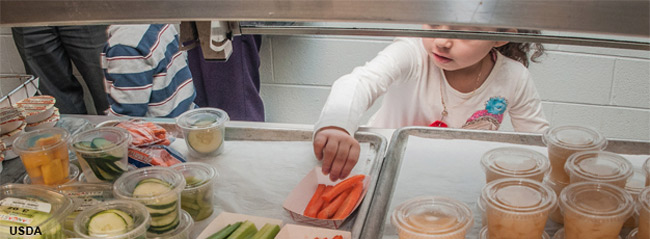
Open a child’s lunch box and you’re likely to find that the lunches and snacks inside fall short of federal guidelines. Those are the findings of a study conducted by researchers at the Friedman School of Nutrition Science and Policy at Tufts University and in the Department of Public Health and Community Medicine at Tufts University School of Medicine. The findings are published online ahead of print in the Journal of the Academy of Nutrition and Dietetics.
Led by senior author Jeanne Goldberg, Ph.D., R.D., a professor at the Friedman School, the study is among the first to examine what children bring to school for lunch and snack. The researchers used digital photography to document the lunches and snacks of more than 600 Massachusetts third and fourth graders in 12 schools in six public school districts. Goldberg and colleagues compared students’ lunch and snack items to federal National School Lunch Program (NSLP) and Child and Adult Food Care Program (CAFCP) standards, respectively. They found that only 27% of the lunches met at least three of the five NSLP standards, and only 4% of snacks met at least two of the four CAFCP standards, both of which emphasize fruits, vegetables, whole grains and low- or non-fat dairy.
The findings highlight the challenges associated with packing healthful items to send to school. “When deciding what to pack, parents are juggling time, cost, convenience, and what is acceptable to their children. Unfortunately, these factors are not always in harmony with good nutrition,” Goldberg said.
“Lunches were comprised more of packaged foods than anything else,” Goldberg said. “Almost a quarter of the lunches lacked what would be considered an entrée, such as a sandwich or leftovers, and were instead made up of a variety of packaged snack foods and desserts.”
“The few existing studies on packed lunches report that children who bring their lunch tend to consume fewer fruits and vegetables, less fiber and more total calories than those who participate in the National School Lunch Program,” Goldberg said. “Given that over 40% of U.S. schoolchildren bring their lunches to school on a given day, it’s important to consider how nutrition experts and policymakers could help parents meet the challenges of cost, convenience, and child preference and add nutrition to the equation.”
The researchers also found considerable room for improvement in school snacks. Goldberg and colleagues found that a typical snack consisted of one or more sugar-sweetened beverages paired with a packaged snack food or dessert. “Few studies have evaluated snacks from home and our data suggest that classroom-based snacking presents another opportunity for kids to eat and drink high calorie and nutrient-poor foods and beverages,” said corresponding author Kristie Hubbard, Ph.D., M.P.H., R.D., a research associate at the Friedman School.
“Although water was slightly more common than sugar-sweetened beverages at lunchtime, we saw many children with two or three sugary drinks in their lunchboxes,” said Hubbard. “Replacing sugary drinks with water – the drink recommended by the American Academy of Pediatrics – keeps children hydrated without adding extra sugar to their diet.”
The current study evaluated one day’s worth of lunches and snacks in 12 schools. Goldberg and colleagues acknowledge the need for larger studies of more diverse groups of students over an extended period of time.
This study points to the need to help parents find ways to build nutrition into the packed-lunch routine. The researchers acknowledge that this is a challenge that will require creative approaches to packing lunch boxes with affordable, easy-to-prepare, and healthy options while at the same time creating a demand for these options among children.
The study done by Tufts University.